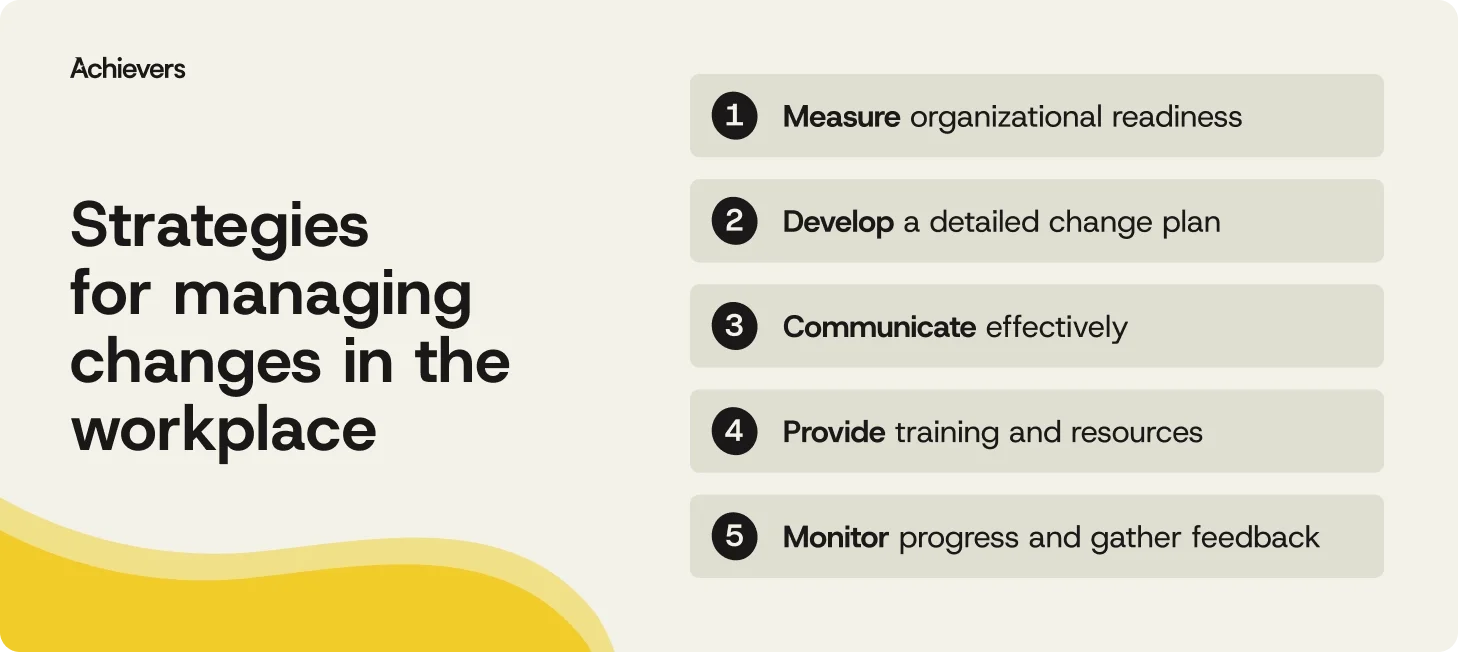Table of contents
Managing changes in the workplace isn’t a once-in-a-while event — it’s the job.
And yet, 54% of CHROs say their change strategies aren’t engaging employees the way they should, according to Gartner. That’s a big gap between good intentions and actual impact — and it often comes down to one thing: how employees experience the change.
Handled well, change doesn’t drain your team; it energizes them. It creates alignment, sparks momentum, and builds resilience. But it takes more than a plan on paper. It takes connection, clarity, and yes, a whole lot of communication.
In this blog, we’ll break down five practical ways to manage change with more empathy, more structure, and a lot less chaos.
5 key strategies to manage workplace change
There’s no single script for change — and that’s exactly why it’s tricky. But some approaches consistently help teams stay steady through the uncertainty. These five strategies can help you lead change in a way that feels clear, collaborative, and human — not like you’re sprinting through a fire drill:

1. Measure organizational readiness
You can’t lead change if you don’t know what you’re working with. Before launching a new initiative, take the pulse of your people and processes. Skipping this step? That’s how surprises happen…and not the fun kind.
- Use surveys, interviews, or readiness assessments to understand attitudes, confidence, and capability gaps.
- Look for early signs of resistance or support so you can address them before they escalate.
2. Develop a detailed change plan
Clarity is your best friend in times of change. A thoughtful plan not only keeps things on track — it shows your team this isn’t improv.
- Map out goals, timelines, milestones, and ownership. Who’s doing what, and when?
- Make sure your plan reflects your company’s core values and real-world workflows; not just what looks good in a deck.
3. Communicate effectively
If people don’t understand what’s changing, why it matters, and how it affects them, they’ll fill in the blanks themselves. And that rarely ends well.
- Mix up your communication channels — think town halls, emails, manager briefings, and Slack updates.
- Prioritize transparent communication and two-way dialogue. Communication isn’t just talking at your team — it’s listening, too.
4. Provide training and resources
Even the best strategies can stall if your team doesn’t feel equipped to keep up. Change without support isn’t empowering, it’s overwhelming.
- Offer practical, easy-to-access resources like workshops, micro-learnings, or cheat sheets.
- Focus on what employees need to do differently and give them the tools to succeed.
5. Monitor progress and gather feedback
- Change isn’t “set it and forget it.” You need checkpoints and the ability to pivot if things aren’t landing.
- Use pulse surveys, team check-ins, and data to track progress and sentiment.
When you hear feedback, act on it. Nothing builds trust like showing that input actually drives improvement.
Best practices for managing change in the workplace
Rolling out change is one thing. Embedding it into your organizational culture is another. The best change strategies don’t stop at launch; they focus on sustaining momentum and reinforcing new behaviors over time. These best practices can help you keep change on track, long after the kick-off meeting ends.
1. Reinforce the “why” through recognition
When employees are recognized for embracing new behaviors, those behaviors stick. Recognition isn’t just about celebration — it’s a tool for alignment.
- Shout out early adopters who are modeling the change.
- Tie recognition directly to the actions and mindsets you want to see more of.
It’s a fast, visible way to shape culture and keep progress moving forward.
2. Use data to spot friction points
Change doesn’t always stall loudly. Sometimes it fizzles quietly in the background. That’s where feedback and insights matter.
- Use employee feedback tools and engagement metrics to track how people are adjusting.
- Act fast on what you learn; even small changes can reignite momentum.
As Achievers’ messaging puts it: when you’ve got the right data in hand, you can shape behavior and drive real results.
3. Keep employees in the loop
Change shouldn’t be something that happens to your people. Ongoing input keeps them engaged and invested.
- Ask how the transition is landing and co-create solutions when things hit a snag.
- Create space for employee-led initiatives, pilots, or tweaks to processes.
Recognized and empowered employees are more likely to stay committed through the ups and downs.
4. Make change part of the flow of work
The more friction your new process creates, the faster it will be abandoned. Integrate change into the tools, routines, and rhythms your people already use.
- Sync new workflows with familiar platforms.
- Provide just-in-time resources instead of overwhelming all-at-once training.
Change that fits into the day-to-day is more likely to last, especially when it feels like less work, not more.
How Achievers helps you turn change into lasting impact
It’s one thing to manage change. It’s another to actually make it stick. Achievers helps you do both — by keeping your people engaged, recognized, and in the loop every step of the way.
Here’s how the platform makes that easier:
- Reinforce the right behaviors, right away: Recognize and reward the actions that support change as they happen — so people know what’s working and feel good doing it.
- Keep your team engaged through uncertainty: Regular, meaningful recognition helps employees stay motivated and focused — even when things are shifting around them.
- See how change is landing in real time: Use the Voice of Employee tools to check in, gather feedback, and make quick course corrections when needed.
- Make recognition easy to scale: Automated tools and integrations mean you can keep the momentum going — without piling more work on your plate.
- Connect culture to results: When people feel valued, they show up stronger. Need proof? According to the Achievers Workforce Institute, 98% of employees who are recognized at least monthly meet or exceed expectations. That’s recognition that makes a real difference to your people and your business.
Start mastering the art of workplace change
Change doesn’t have to feel chaotic or exhausting. With the right strategies in place, you can lead your team through transitions with clarity, connection, and a lot less stress.
The key? Make it human. Listen often. Recognize progress. And don’t treat change as a one-and-done; treat it as a chance to grow stronger, together.
When you combine thoughtful planning with tools like Achievers — designed to keep people engaged, heard, and supported — change becomes more than a challenge. It becomes a culture-shaping opportunity.



